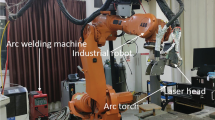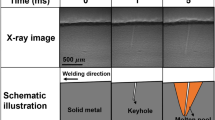Abstract
In this work, the thermal characteristics of the weld pool during Yb:YAG laser welding of the AA5083-H111 aluminum alloy were captured using an infrared thermal imaging camera and a numerical model was developed to predict the temperature fields using COMSOL Multiphysics software. On comparing the measured and predicted temperature of the weld pool surface, the deviation was below 10 °C and the average experimental error was not more than 1%. It shows the reliability of IR camera used in this investigation. Also, it was apparent from the thermal images that at a higher beam power, an erratic molten pool was created due to the instability of keyhole and spatters were ejected from the molten pool. The higher recoil pressure built at the walls of keyhole due to the high intensity of the laser beam and instigation of the ejected fluid flow mechanism was responsible for this occurrence. Also, the formation and floating mechanisms of process-induced porosities were analyzed. Porosities were identified in the weldments processed with longer shielding gas blown distance (30 mm), whereas other welds had no porosities. Since the gas blown distance was more, gas pressure over the molten pool was not sufficient to suppress the plasma plume and, thereby, results in porosity formation. Interestingly, a high number of porosities were evident at the toe of the weld bead and it was assumed to be caused by the high thermal gradient-induced Marangoni flow. This study provides a better understanding of molten pool behavior, porosity formation and its floating mechanism.







Similar content being viewed by others
References
Yuewei A, Ping J, Xinyu S, Peigen L, Chunming W. A three-dimensional numerical simulation model for weld characteristics analysis in fiber laser keyhole welding. Int J Heat Mass Transf. 2017;108:614–26.
Lijin H, Dongsheng W, Xueming H, Shichao L, Zhao J, Fang L, Huan W, Shaojian S. Effect of the welding direction on the microstructural characterization in fiber laser-GMAW hybrid welding of 5083 aluminum alloy. J Manuf Process. 2018;31:514–22.
Dabin Z, Canli L, Xixia L, Yang C, Dongsheng W. Numerical study of spatter formation during fiber laser welding of aluminum alloy. J Manuf Process. 2018;31:72–9.
Sanchez A, Delgado T, Gonza L, Botana FJ. Laser welding of aluminium alloys 5083 and 6082 under conduction regime. Appl Surf Sci. 2009;255:9512–21.
Chinnapat P, Bama P, Mark W, Nathanael T, Richard P, Jeffery B, Hector C. Keyhole formation and thermal fluid flow-induced porosity during laser fusion welding in titanium alloys: experimental and modelling. Acta Mater. 2017;126:251–63.
Masiyang L, Yung CS. Vision-based weld pool boundary extraction and width measurement during keyhole fiber laser welding. Opt Lasers Eng. 2015;64:59–70.
Kai L, Fenggui L, Haichao C, Xibin L, Xinhua T, Zhuguo L. Investigation on the effects of shielding gas on porosity in fiber laser welding of T-joint steels. Int J Adv Manuf Technol. 2015;77:1881–8.
Baohua C, Jon B, Chris A, Paul H. Studies on the spatter behaviour when welding AA5083 with a Yb-fibre laser. Int J Adv Manuf Technol. 2016;84:1769–76.
Simone M, Dominique G, Alexandre M, Laetitia K. Using infrared thermography in order to compare laser and hybrid (laser + MIG) welding processes. Opt Laser Technol. 2009;41:665–70.
Maryna S, Simone M, Michel P, Mariana I. The infrared thermography control of the laser welding of amorphous polymers. NDT & E Int. 2008;41:178–83.
Huang RS, Liu LM, Song G. Infrared temperature measurement and interference analysis of magnesium alloys in hybrid laser-TIG welding process. Mater Sci Eng A. 2007;447:239–43.
Tsirkas SA, Papanikos P, Kermanidis TH. Numerical simulation of the laser welding process in butt-joint specimens. J Mater Process Technol. 2003;134:59–69.
Runqi L, Hui W, Fenggui L, Joshua S, Blair C. Numerical study of keyhole dynamics and keyhole-induced porosity formation in remote laser welding of Al alloys. Int J Heat Mass Transf. 2017;108:244–56.
Matsunawa A, Mizutani M, Katayama S, Seto N. Porosity formation mechanism and its prevention in laser welding. Weld Int. 2003;17(6):431–7.
Dongsheng W, Xueming H, Lijin H, Jiang Z. Numerical simulation of spatter formation during fiber laser welding of 5083 aluminum alloy at full penetration condition. Opt Laser Technol. 2018;100:157–64.
Dongsheng W, Xueming H, Fang L, Lijin H. Understanding of spatter formation in fiber laser welding of 5083 aluminum alloy. Int J Heat Mass Transf. 2017;113:730–40.
Haboudou A, Peyre P, Vannes AB, Peix G. Reduction of porosity content generated during Nd:YAG laser welding of A356 and AA5083 aluminium alloys. Mater Sci Eng A. 2003;363:40–52.
Sanchez A, Delgado T, Damborenea JJ, Lopez V, Botana FJ. Laser welding of AA 5083 samples by high power diode laser. Sci Technol Weld Join. 2009;14(1):78–86.
Marcin K, Wiesława P, Sebastian S. Modelling of laser beam heat source based on experimental research of Yb:YAG laser power distribution. Int J Heat Mass Transf. 2015;83:679–89.
Tsirkas SA. Numerical simulation of the laser welding process for the prediction of temperature distribution on welded aluminium aircraft components. Opt Laser Technol. 2018;100:45–56.
Hamidreza H, Homam NM. Hot cracking in pulsed Nd:YAG laser welding of AA5456. Opt Laser Technol. 2018;103:22–32.
Lei W, Yanhong W, Jicheng C, Wenyong Z. Macro-micro modeling and simulation on columnar grains growth in the laser welding pool of aluminum alloy. Int J Heat Mass Transf. 2018;123:826–38.
Lijin H, Xueming H, Dongsheng W, Li F, Yan C, Youxiong Y. Effect of magnesium content on keyhole-induced porosity formation and distribution in aluminum alloys laser welding. J Manuf Process. 2018;33:43–53.
Kakitani R, de Gouveia GL, Garcia A, Cheung N, Spinelli J. Thermal analysis during solidification of an Al–Cu eutectic alloy: interrelation of thermal parameters, microstructure and hardness. J Therm Anal Calorim. 2019;137:983–96. https://doi.org/10.1007/s10973-018-07992-x.
Krol M, Snopinski P, Czech A. The phase transitions in selective laser-melted 18-NI (300-grade) maraging steel. J Therm Anal Calorim. 2020. https://doi.org/10.1007/s10973-020-09316-4.
Chulkov AO, Sfarra S, Saeed N, Ibarra-Castanedo C, Gargiulo G, Steenackers G, Maldague XPV, Omar MA, Vavilov V. Evaluating quality of marquetries by applying active IR thermography and advanced signal processing. J Therm Anal Calorim. 2020. https://doi.org/10.1007/s10973-020-09326-2.
Acknowledgements
The authors would like to express their most profound appreciation and sincere thanks to the Department of Science and Technology—Science and Engineering Research Board (DST-SERB), New Delhi, India, for financially supporting this entire research work, under the sponsored research project sanctioned no. SB/EMEQ-168/2014, dated 29-01-2016.
Author information
Authors and Affiliations
Corresponding author
Additional information
Publisher's Note
Springer Nature remains neutral with regard to jurisdictional claims in published maps and institutional affiliations.
Rights and permissions
About this article
Cite this article
Umar, M., Paulraj, S. Thermography analysis and porosity formation during laser beam welding of AA5083-H111 aluminum alloy. J Therm Anal Calorim 146, 1551–1559 (2021). https://doi.org/10.1007/s10973-020-10140-z
Received:
Accepted:
Published:
Issue Date:
DOI: https://doi.org/10.1007/s10973-020-10140-z




